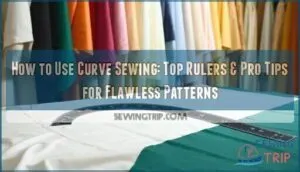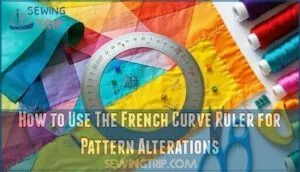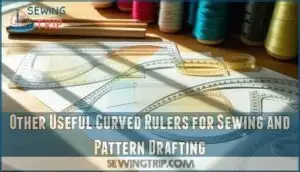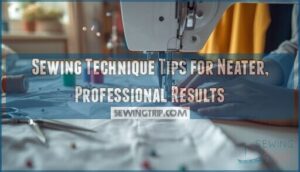This site is supported by our readers. We may earn a commission, at no cost to you, if you purchase through links.

That’s where mastering how to use curve sewing comes in. Grab a French curve or hip curve ruler, place it along the seam line, and trace a smooth arc.
Suddenly, those sharp corners vanish, and your pattern fits like magic. Use gentle pressure and slide the ruler where needed for a natural shape—don’t force it, or your fabric will tell on you.
Once you get the hang of it, you’ll find yourself reaching for curves every time. There’s an art to it—let’s unravel more.
Table Of Contents
- Key Takeaways
- French Curve Ruler: The Essential Sewing Tool
- How to Use The French Curve Ruler for Pattern Alterations
- The Hip Curve: Achieving Perfect Fit for Hips, Lapels, and Elbows
- Other Useful Curved Rulers for Sewing and Pattern Drafting
- Top 5 Curved Rulers for Sewing and Pattern Alterations
- Frequently Asked Questions (FAQs)
- Conclusion
Key Takeaways
- Use a French curve or hip curve ruler to shape smooth seams and upgrade your pattern’s fit—no more sharp corners or guesswork.
- Line up the curve ruler closely along edges, then pivot gently as you trace for natural, balanced curves on necklines, armholes, waists, and hips.
- Choose rulers made from sturdy, ergonomic materials so you stay comfortable and accurate during long sewing sessions.
- Keep your curved rulers clean and store them flat so you’ll always get crisp, distortion-free lines on every project.
French Curve Ruler: The Essential Sewing Tool
Anybody who’s wrestled with tricky sewing curves knows that French curve rulers are a game-changer in your sewing tool kit.
Master any sewing curve with a French curve ruler—your secret weapon for smooth, pro-level results every time.
These curved rulers have a cool backstory—Curve Ruler History dates to fashion houses needing flawless pattern perfection.
Made from plastic, metal, or wood, they each come with their quirks, so think about Ruler Material Comparison before picking yours.
Ergonomic curve rulers are easy on the hands, just what you need for long sessions at the sewing table.
While you might be tempted by shiny Digital Curve Alternatives, nothing quite beats the hands-on control of a real French curve.
With advanced curve techniques, blending armholes or necklines feels less like guesswork and more like magic.
Clear rulers offer visibility and accuracy when marking straight lines.
Every pro sewist swears by these rulers for smooth, expert-level results.
How to Use The French Curve Ruler for Pattern Alterations
You’ll use the French curve ruler to shape necklines, armholes, and pattern edges with precision that your scissors can only dream of.
Move beyond rough cuts—shape flawless necklines and armholes with the precision only a French curve ruler delivers.
It’s surprisingly simple—once you stop mistaking the ruler for modern art, you’ll create smooth adjustments and balanced designs every time.
Adjusting Necklines and Armholes
When tackling neckline depth or tweaking armhole shape, grab your French curve for smooth, custom changes.
Here’s your four-step plan:
- Trace the current edge to reveal the curve.
- Pivot the ruler to target your desired neckline adjustments or armhole adjustments.
- Check both sides for curve symmetry.
- Refine shoulder slope to fix sneaky fit issues—no more lopsided seams!
An armhole adjustment ruler can further refine these custom changes to ensure a perfect fit, making it easier to achieve smooth alterations.
Creating Smooth Curves for Waist and Hip Adjustments
Ever wonder how designers get those flawless waist and hip curves?
Grab your French curve ruler and say goodbye to sharp corners.
For waist curve shaping and hip curve blending, align the ruler along the pattern’s edge, pivot gently, and trace a smooth line.
Seamless size shifts depend on steady, even pressure.
Consistent curve maintenance means adjusting in small increments.
With these curve sewing tips and handy hip curves, you’ll master pattern grading accuracy and confident waist adjustments in no time.
You can find a great selection of French curve rulers online to help with these tasks.
Blending and Grading Patterns With The French Curve Ruler
Blending and grading patterns with French curves is your ticket to smooth size shifts and flawless pattern flow.
No more blending challenges or lumpy edges—align your ruler with key points, pivot to connect sizes, and trace gently for curve consistency.
Dial in grading accuracy with steady pressure and let clean lines do the heavy lifting in pattern drafting and making.
- Smooth size jumps feel magical
- No more “wonky” shifts
- Say goodbye to guessing curves
- Patterns finally make sense
- Detail work suddenly gets fun
The Hip Curve: Achieving Perfect Fit for Hips, Lapels, and Elbows
Getting comfortable with the hip curve reveals real confidence in curve sewing.
This tool makes hip adjustments a breeze—just rest it along your pattern’s hipline and spot awkward angles before they become fit issues.
For lapel shaping, match the ruler’s curve to your lapel edge and trace a smooth line that says goodbye to gaping collars.
When you’re tackling elbow adjustments, align the hip curve along the sleeve’s armhole and then pivot it gently for a natural dart.
Curve selection matters: try a Dritz or Fairgate hip ruler to see which fits your hand best.
Mastering Hip Curves turns pattern alterations from guesswork into precision.
Understanding the need for bodice pattern adjustments is equally important for achieving a great fit.
Other Useful Curved Rulers for Sewing and Pattern Drafting
You don’t have to stop at just the French Curve—other curved rulers can make your pattern drafting smoother and more accurate.
Once you try a few of these, you might find your sewing toolbox is multiplying faster than your scrap pile.
The Vary Form Curve Ruler by Fairgate
When you’re aiming for sharp Pattern Alterations after fine-tuning hips, the Fairgate Vary Form Curve Ruler steps in as your all-star.
Thanks to its Lightweight Design and flexible curve ruler shape, you’ll glide through Drafting Applications—necklines, armholes, and even that tricky curved seam allowance—without breaking a sweat.
Want Accurate Measurements? This is your trusty sidekick for sewing curves smoothly or nudging a collar curve just right.
You can find a Fairgate vary form for purchase online.
Here’s what you’ll love:
- Draws a wide range of curves with ease
- Perfect for both minor tweaks and bold moves
- Supports advanced curve sewing techniques
The Sew Easy French Curve Ruler
If the Vary Form Curve makes you feel like a pattern pro, wait until you get your hands on the Sew Easy French Curve Ruler.
Its transparent acrylic body and grading grid let you visualize every adjustment for personalized sizing. Accurate, clear markings mean precise measurements are a breeze.
Use it for pattern adjustments along necklines, sleeves, or hips—curve sewing techniques just got easier.
Lose the guesswork when sewing curved seams or marking curved seam allowance for smooth, pro-level results.
The Dritz Styling Design Ruler
Let’s leave complicated gadgets behind—the Dritz Styling Design Ruler brings budget-friendly curves and clever design applications right to your sewing table.
It’s only 12 inches, but don’t let the size fool you; it’s got big personality for sewing curved seams and lines. Flip it to trace necklines, grade sizes, or draft a new sleeve.
It’s also useful for pattern and garment alterations, making it a versatile tool.
Durable but with durability concerns if dropped hard, it’s loved for its user experience and double-duty as a curve sewing guide or marking tool.
Top 5 Curved Rulers for Sewing and Pattern Alterations
A trusty curved ruler can smooth out your sewing curved seams and upgrade your curve sewing patterns.
For Ruler Comparison, here are five top picks that prove accuracy matters, ergonomic design doesn’t have to break the bank, and material durability is key for sewing curved lines.
- Pacific Arc French Curve Set: Versatile, transparent, reliable.
- Dritz Clear Curved Hip Drafting Ruler: Gridded for spot-on curved fabric cutting.
- Fairgate 24 Inch Curved Monitor: Accurate, sturdy classic.
- Fairgate 12 Inch Vary Form: Lightweight, multipurpose.
- Sew Easy French Curve: Budget option, great for sewing curved edges.
These tools are also essential for making fitting adjustments to sewing patterns, which highlights the importance of sewing curved seams and having a reliable curved ruler.
Frequently Asked Questions (FAQs)
How does curve stitching work?
Curve stitching means joining two curved fabric pieces by aligning edges, pinning carefully, and using a short stitch length.
As you sew, pivot the fabric slowly, clip seams for smooth turns, and don’t rush—you’ll nail it.
How to maintain and clean curve sewing tools?
Wipe your rulers and presser feet with a damp cloth after use—don’t let threads or chalk build up.
Avoid harsh cleaners; mild soap works fine.
Store tools flat, away from direct sunlight, so they don’t warp or crack, and remember to wipe your rulers and presser feet regularly to maintain them.
What fabrics are hardest to sew with curves?
Spandex acts like a bull in a china shop when you sew curves—slippery, stretchy, and wild.
Slick satins, silk, and chiffon slip around, fray easily, and fight your needle every step of the way, which can make the sewing process particularly challenging with stretchy fabrics.
How to choose seam allowance for curved seams?
Pick a 1/4-inch seam allowance for most curved seams—this helps the fabric turn smoothly.
If your pattern doesn’t mention it, add one. Wider allowances can get bulky, so keep it lean for crisp results.
Can curved rulers help with quilting projects?
Ever felt like quilting corners are plotting against you?
Curved rulers save the day by helping you draw precise arcs, blend patchwork pieces, and nail those smooth quilt curves—just line up, trace, and stitch confidently.
Tips for troubleshooting puckered curved seams?
Check your tension, use plenty of pins, and don’t yank the fabric as you sew.
Shorten your stitch length.
Clip seams on tight curves.
A quick press with steam after stitching usually tames stubborn puckers.
Conclusion
Mastering curves in sewing is like steering a canoe through winding rivers—precision and the right tools make all the difference.
When you master how to use curve sewing, patterns flow more naturally, and sudden bends won’t sink your confidence.
Pick the proper curved ruler, trace with steady hands, and let your creativity glide.
It’s not wizardry, just solid technique and a good ruler.
Every curve you sew becomes smoother, shaping garments that fit and flatter every time.
- https://www.wardrobesupplies.com/dritz-4-in-1-styling-design-ruler.html
- https://www.youtube.com/watch?v=lEBSy984-O4
- https://www.123stitch.com/item/Dritz-Styling-Design-Ruler/DRITZ-852
- https://www.nascoeducation.com/dritz-24-in-styling-design-ruler-ne40128.html
- https://shopsavvy.com/answers/can-the-dritz-styling-design-ruler-be-used-for-pattern-drafting









